STOCK SELLING RING
19 SPRING STREET CASTERTON, GLENELG SHIRE
-
Add to tour
You must log in to do that.
-
Share
-
Shortlist place
You must log in to do that.
- Download report
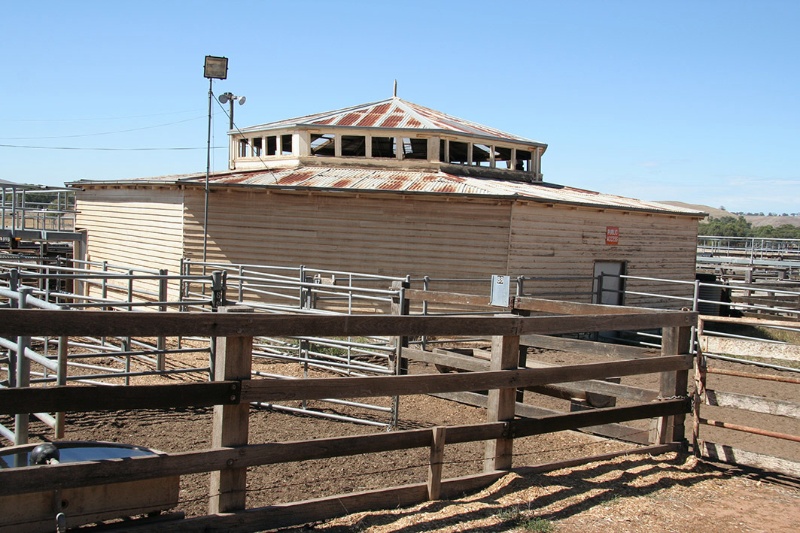



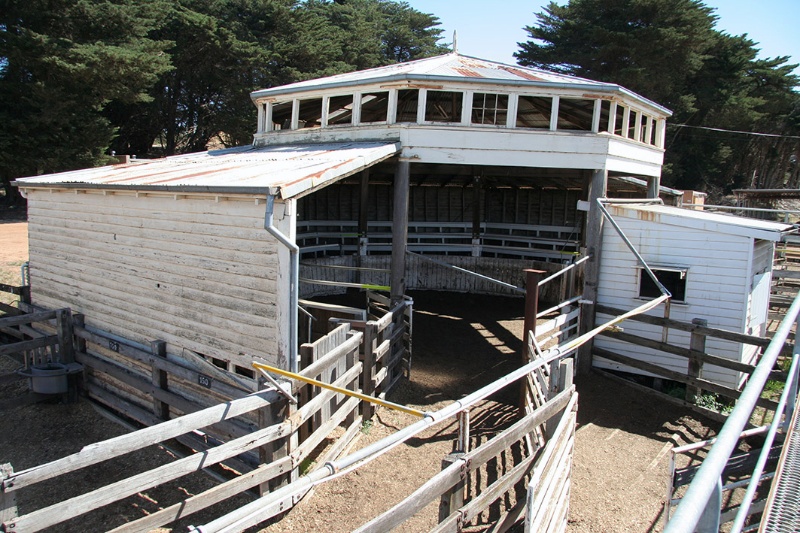
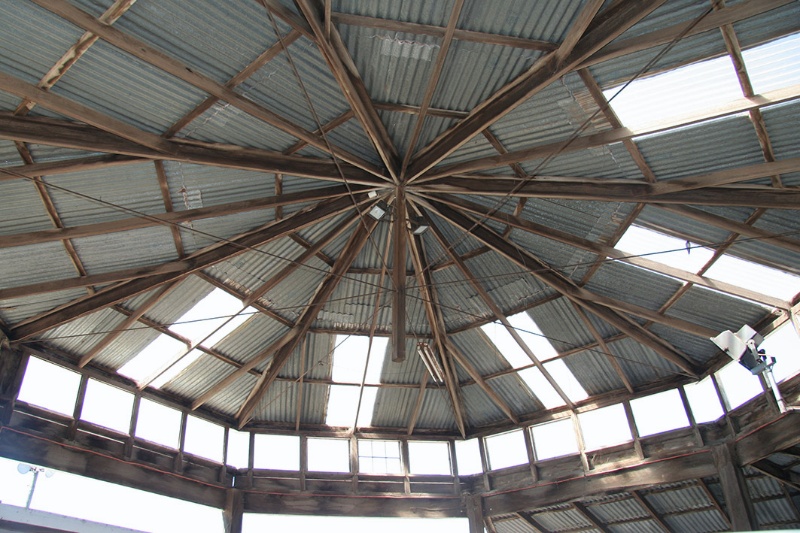
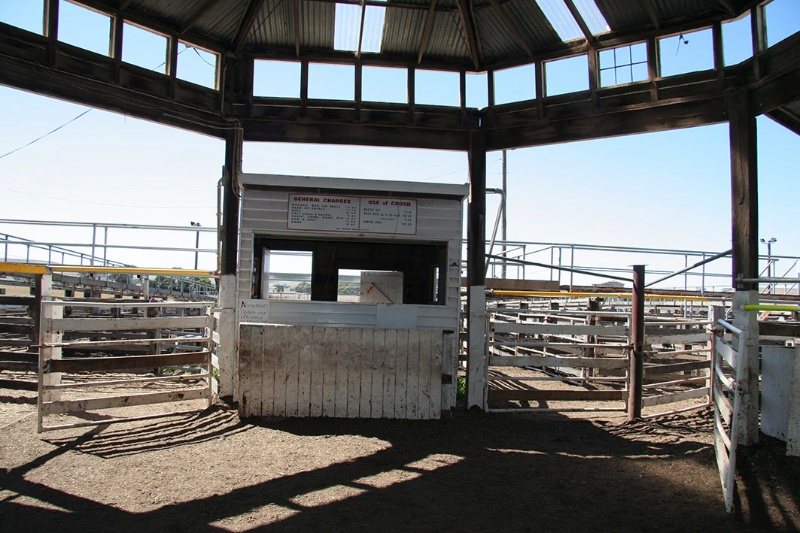
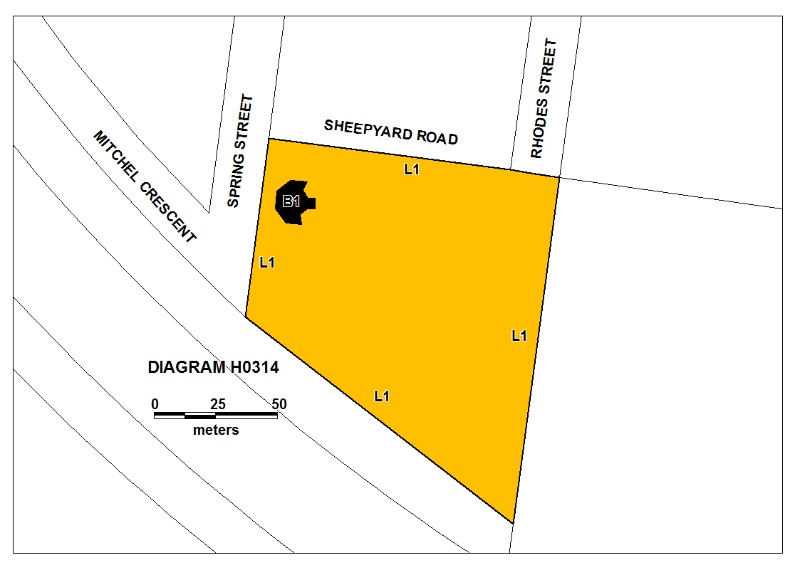
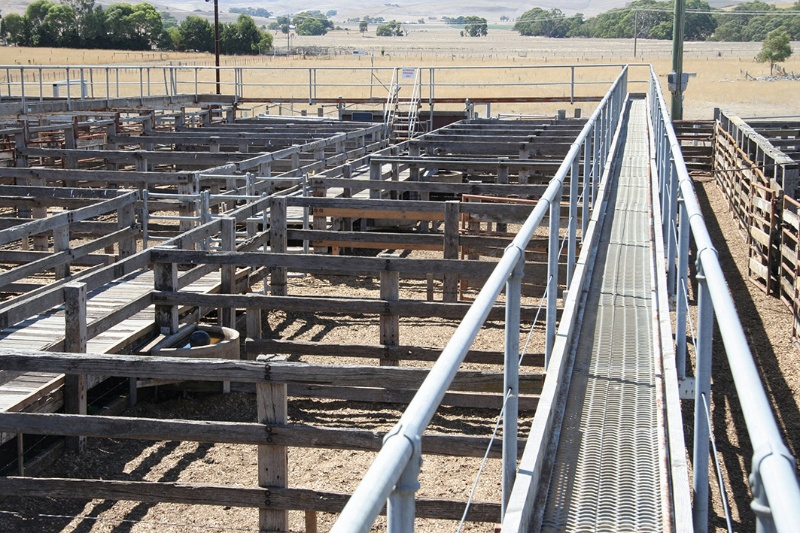
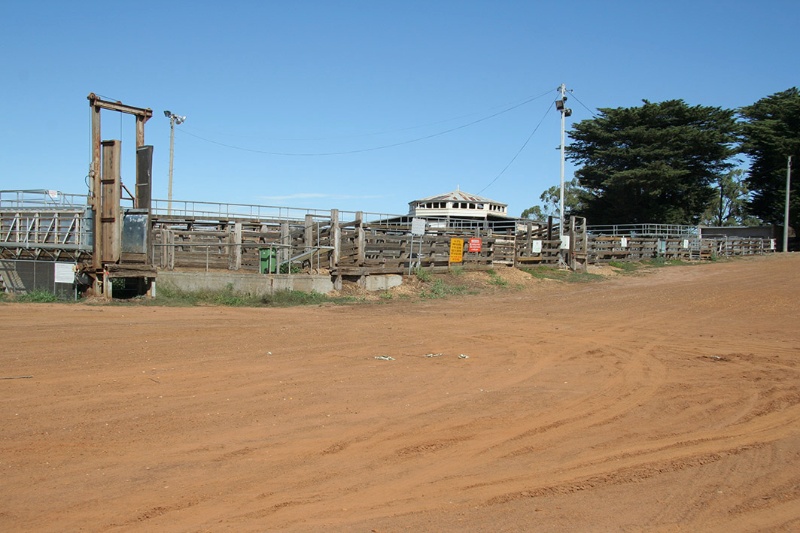
Statement of Significance
What is significant?
The Casterton Stock Selling Ring building is located in the municipal cattle sale yards across the Wannon River to the south of the Casterton town centre. The plan of the stock selling ring building is based on an octagon within an octagon. The inner ring, for presentation of stock, is surrounded by timber planking and steel tube barriers, and is covered by an octagonal lantern roof on heavy hardwood posts. Tiered timber seating surrounds the ring on five sides, broken by a central pedestrian entrance way approached from outside the yards to the east. The seating area is enclosed with weatherboard stud-framed walls and corrugated iron roofing. On the other three sides the ring is open, with the central bay occupied by a weatherboard auctioneers box and the openings on either side having gates for stock from the yards beyond. The open sides on an octagonal stock selling ring building are unusual, and give a strong connection to the yards surrounding it.
The Casterton stock selling ring dates from the mid 1920s when the new municipal sale yards were opened. Prior to this there were private stock selling yards at a number of points around the town, and cattle were droved through the main street. With public demand for demand for better, larger, publicly owned yards away from the town centre, the Shire Council started planning municipal yards from 1913. Plans for the current site begun in 1918. The yards were opened in 1925, with further construction occurring in 1926. The Stock Selling Ring building was probably designed by the long serving Shire Engineer, Claude Alexander Mickle and built by the local contractors, John and Ernest Spurrell, who won the tender for the yards. The ring was mainly used for selling bulls or pedigree cows and, sometimes, for selling horses. It is now used for breaking out stock, and the seating is used for eating lunch. The two big weaner store sales held by stock agents in January are the major annual events at the Casterton yards. Cattle from this area are recognised as being of high quality, and the ongoing use of these yards is considered an important factor in maintaining this regional identity.
How is it significant?
The Casterton Stock Selling Ring is of architectural and historical significance to the State of Victoria.
Why is it significant?
The Casterton Stock Selling Ring is of architectural significance as one of the few remaining examples of the specialized building type of the stock selling ring, which was once common in the State. The Casterton Stock Selling Ring is of architectural significance within the variations of that building type, as an example of the use of an octagonal building form for an enclosed ring. The Casterton building is also unusual as an octagonal selling ring with partly open sides, where other remaining octagonal examples in the State are fully enclosed.
The Casterton Stock Selling Ring is of historical significance for its association with the development of the pastoral industry in Victoria following selection and Soldier Settlement, and in particular with the development of activities and facilities associated with the sale and distribution of livestock.
The Casterton Stock Selling Ring is of historical significance for its association with the increasing involvement of rural local governments in building and running stockyards from the beginning of the twentieth century.
The Casterton Stock Selling Ring is of historical significance for its association with the sale of livestock in the further Western District, reflecting the increasing market of the selection and closer settlement periods and the post-War prosperity of the 1920s. The selling ring and the cattle yards demonstrate the importance of Casterton as a source of quality breeding stock for the pastoral industry.
-
-
STOCK SELLING RING - Plaque Citation
In the 1920s Casteron was a centre for quality breeding stock for the pastoral industry. The ring (c.1925) used for the sale of cattle and horses is one of few remaining in Victoria.
STOCK SELLING RING - Permit Exemptions
General Exemptions:General exemptions apply to all places and objects included in the Victorian Heritage Register (VHR). General exemptions have been designed to allow everyday activities, maintenance and changes to your property, which don’t harm its cultural heritage significance, to proceed without the need to obtain approvals under the Heritage Act 2017.Places of worship: In some circumstances, you can alter a place of worship to accommodate religious practices without a permit, but you must notify the Executive Director of Heritage Victoria before you start the works or activities at least 20 business days before the works or activities are to commence.Subdivision/consolidation: Permit exemptions exist for some subdivisions and consolidations. If the subdivision or consolidation is in accordance with a planning permit granted under Part 4 of the Planning and Environment Act 1987 and the application for the planning permit was referred to the Executive Director of Heritage Victoria as a determining referral authority, a permit is not required.Specific exemptions may also apply to your registered place or object. If applicable, these are listed below. Specific exemptions are tailored to the conservation and management needs of an individual registered place or object and set out works and activities that are exempt from the requirements of a permit. Specific exemptions prevail if they conflict with general exemptions. Find out more about heritage permit exemptions here.Specific Exemptions:Miaintenance and alterations to the Cattle Yards: The following works are permit exempt under section 66 of the Heritage Act 1995 - Ongoing maintenance of the cattle yards and alterations to the cattle yards necessary to comply with regulations and standards except where proposed changes are within an area of three metres around the outside of the stock selling ring building and the auctioneer's booth.
General Conditions: 1. All exempted alterations are to be planned and carried out in a manner which prevents damage to the fabric of the registered place or object. General Conditions: 2. Should it become apparent during further inspection or the carrying out of works that original or previously hidden or inaccessible details of the place or object are revealed which relate to the significance of the place or object, then the exemption covering such works shall cease and Heritage Victoria shall be notified as soon as possible. Note: All archaeological places have the potential to contain significant sub-surface artefacts and other remains. In most cases it will be necessary to obtain approval from the Executive Director, Heritage Victoria before the undertaking any works that have a significant sub-surface component. General Conditions: 3. If there is a conservation policy and plan endorsed by the Executive Director, all works shall be in accordance with it. Note: The existence of a Conservation Management Plan or a Heritage Action Plan endorsed by the Executive Director, Heritage Victoria provides guidance for the management of the heritage values associated with the site. It may not be necessary to obtain a heritage permit for certain works specified in the management plan. General Conditions: 4. Nothing in this determination prevents the Executive Director from amending or rescinding all or any of the permit exemptions. General Conditions: 5. Nothing in this determination exempts owners or their agents from the responsibility to seek relevant planning or building permits from the responsible authorities where applicable. Regular Site Maintenance : The following site maintenance works are permit exempt under section 66 of the Heritage Act 1995: a) regular site maintenance provided the works do not involve the removal or destruction of any significant above-ground features or sub-surface archaeological artefacts or deposits; b) the maintenance of an item to retain its conditions or operation without the removal of or damage to the existing fabric or the introduction of new materials; c) cleaning including the removal of surface deposits, organic growths, or graffiti by the use of low pressure water and natural detergents and mild brushing and scrubbing; d) repairs, conservation and maintenance to plaques, memorials, roads and paths, fences and gates and drainage and irrigation. e) the replacement of existing services such as cabling, plumbing, wiring and fire services that uses existing routes, conduits or voids, and does not involve damage to or the removal of significant fabric. Note: Surface patina which has developed on the fabric may be an important part of the item's significance and if so needs to be preserved during maintenance and cleaning. Note: Any new materials used for repair must not exacerbate the decay of existing fabric due to chemical incompatibility, obscure existing fabric or limit access to existing fabric for future maintenance. Repair must maximise protection and retention of fabric and include the conservation of existing details or elements. Fire Suppression Duties : The following fire suppression duties are permit exempt under section 66 of the Heritage Act 1995, a) Fire suppression and fire fighting duties provided the works do not involve the removal or destruction of any significant above-ground features or sub-surface archaeological artefacts or deposits; b) Fire suppression activities such as fuel reduction burns, and fire control line construction, provided all significant historical and archaeological features are appropriately recognised and protected; Note: Fire management authorities should be aware of the location, extent and significance of historical and archaeological places when developing fire suppression and fire fighting strategies. The importance of places listed in the Heritage Register must be considered when strategies for fire suppression and management are being developed. Weed and Vermin Control : The following weed and vermin control activities are permit exempt under section 66 of the Heritage Act 1995, a) Weed and vermin control activities provided the works do not involve the removal or destruction of any significant above-ground features or sub-surface archaeological artefacts or deposits; Note: Particular care must be taken with weed and vermin control works where such activities may have a detrimental affect on the significant fabric of a place. Such works may include the removal of ivy, moss or lichen from an historic structure or feature, or the removal of burrows from a site that has archaeological values. Public Safety and Security : The following public safety and security activities are permit exempt under section 66 of the Heritage Act 1995, a) public safety and security activities provided the works do not involve the removal or destruction of any significant above-ground structures or sub-surface archaeological artefacts or deposits; b) the erection of temporary security fencing, scaffolding, hoardings or surveillance systems to prevent unauthorised access or secure public safety which will not adversely affect significant fabric of the place including archaeological features; c) development including emergency stabilisation necessary to secure safety where a site feature has been irreparably damaged or destabilised and represents a safety risk to its users or the public. Note: Urgent or emergency site works are to be undertaken by an appropriately qualified specialist such as a structural engineer, or other heritage professional. Signage and Site Interpretation : The following Signage and Site Interpretation activities are permit exempt under section 66 of the Heritage Act 1995, a) signage and site interpretation activities provided the works do not involve the removal or destruction of any significant above-ground structures or sub-surface archaeological artefacts or deposits; b) the erection of non-illuminated signage for the purpose of ensuring public safety or to assist in the interpretation of the heritage significance of the place or object and which will not adversely affect significant fabric including landscape or archaeological features of the place or obstruct significant views of and from heritage values or items; c) signage and site interpretation products must be located and be of a suitable size so as not to obscure or damage significant fabric of the place; d) signage and site interpretation products must be able to be later removed without causing damage to the significant fabric of the place; Note: The development of signage and site interpretation products must be consistent in the use of format, text, logos, themes and other display materials. Note: Where possible, the signage and interpretation material should be consistent with other schemes developed on similar or associated sites. It may be necessary to consult with land managers and other stakeholders concerning existing schemes and strategies for signage and site interpretation. Minor Works : Note: Any Minor Works that in the opinion of the Executive Director will not adversely affect the heritage significance of the place may be exempt from the permit requirements of the Heritage Act. A person proposing to undertake minor works may submit a proposal to the Executive Director. If the Executive Director is satisfied that the proposed works will not adversely affect the heritage values of the site, the applicant may be exempted from the requirement to obtain a heritage permit. If an applicant is uncertain whether a heritage permit is required, it is recommended that the permits co-ordinator be contacted.STOCK SELLING RING - Permit Exemption Policy
The stock selling ring is the part of the site which is of greatest significance and which is most intact and unaltered from the early period of use. Any alterations or additions to the stock selling ring and its immediate surrounds will be subject to permit process.
Maintenance procedures which are now becoming necessary to conserve the Stock Selling Ring building and enable its continued use, such as replacement of areas of roofing iron and painting of weatherboards, will now have a major impact on the appearance of the building and upon the intactness of original fabric. As a result maintenance works will be subject to the permit process, except where identified as minor by the Executive Director under the Minor Works exemption.
In the remainder of the of the site including the cattle yards and effluent treatment area, there has been an ongoing process over many years of renewal and alteration in response to deterioration of materials and changing stock handling practices, regulations and standards. The capacity to make these changes is important to the ongoing use of the yards, which in turn is important to the significance of the Stock Selling Ring. Other than in the immediate surrounds of the Stock Selling Ring, ongoing maintenance and alteration to the yards to enable the continued use of the site as cattle yards will be permit exempt. Older materials should be retained or replaced with like materials where this can be achieved without adverse impact on the operation of the yards. The exemption does not cover major alterations such as the removal of all or a large part of the yards or introduction of new buildings, whichwill have a major impact on the significance of the site and will be subject to permit requirements.
-
-
-
-
-
SACRED HEART CATHOLIC COMPLEX
 Glenelg Shire
Glenelg Shire -
NEW CEMETERY
 Glenelg Shire
Glenelg Shire -
Stock Selling Ring
 National Trust H0314
National Trust H0314
-
'YARROLA'
 Boroondara City
Boroondara City -
1 Bradford Avenue
 Boroondara City
Boroondara City
-
-











